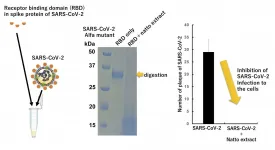(Press-News.org) Rome (Italy), July 21st, 2021 - The remarkable structural properties of the basket sponge (E. aspergillum) might seem fathoms removed from human-engineered structures. However, insights into how the organism's latticework of holes and ridges influences the hydrodynamics of seawater in its vicinity could lead to advanced designs for buildings, bridges, marine vehicles and aircraft, and anything that must respond safely to forces imposed by the flow of air or water.
While past research has investigated the structure of the sponge, there have been few studies of the hydrodynamic fields surrounding and penetrating the organism, and whether, besides improving its mechanical properties, the skeletal motifs of E. Aspergillum underlie the optimization of the flow physics within and beyond its body cavity.
A collaboration across three continents at the frontiers of physics, biology, and engineering led by
Giacomo Falcucci (from the Tor Vergata University of Rome and Harvard University), in collaboration with Sauro Succi (Italian Institute of Technology) and Maurizio Porfiri (Tandon School of Engineering, New York University) applied super computational muscle and special software to gain a deeper understanding of these interactions, creating a first-ever simulation of the deep-sea sponge and how it responds to and influences the flow of nearby water.
The work, "Extreme flow simulations reveal skeletal adaptations of deep-sea sponges" published in the journal Nature, revealed a profound connection between the sponge's structure and function, shedding light on both the basket sponge's ability to withstand the dynamic forces of the surrounding ocean and its ability to create a nutrient-rich vortex within the body cavity "basket."
"This organism has been studied a lot from a mechanical point of view because of its amazing ability to deform substantially in spite of its brittle, glassine structure," said first author Giacomo Falcucci of Tor Vergata University of Rome and Harvard University. "We were able to investigate aspects of hydrodynamics to understand how the geometry of the sponge offers a functional response to fluid, to produce something special with respect to interaction with water"
"By exploring the fluid flow within and outside the body cavity of the sponge, we uncovered the footprints of an expected adaptation to the environment. Not only does the sponge's structure contribute to a reduced drag, but also it facilitates the creation on low-velocity swirls within the body cavity that are used for feeding and reproduction" added Porfiri, a co-author of the study.
The structure of E. Aspergillum, reproduced by co-author Pierluigi Fanelli, of the University of Tuscia, Italy, resembles a delicate glass vase in the form of a thin-walled, cylindrical tube with a large central atrium, siliceous spicules -- thus their commonly used appellation, "glass sponges". The spicules are composed of three perpendicular rays, giving them six points. The microscopic spicules "weave" together to form a very fine mesh, which gives the sponge's body a rigidity not found in other sponge species and allows it to survive at great depths in the water column.
To understand how Venus flower basket sponges do this, the team made extensive use of the Marconi100 exascale-class computer at the CINECA high performance computing center in Italy, which is capable of creating comprehensive simulations using billions of dynamic, temporospatial data points in three dimensions.
The researchers also exploited special software developed by study co-author Giorgio Amati, of SCAI (Super Computing Applications and Innovation) at CINECA, Italy. The software enabled super computational simulations based on Lattice Boltzmann methods, a class of computational fluid dynamics methods for complex systems that represents fluid as a collection of particles and tracks the behavior of each of them.
The in-silico experiments, featuring approximately 100 billion virtual particles, reproduced the hydrodynamic conditions on the deep-sea floor where E. Aspergillum lives. Results processed by Vesselin K. Krastev at Tor Vergata University of Rome allowed the team to explore how the organization of holes and ridges in the sponge improves its ability to reduce the forces applied by moving seawater (a mechanical engineering question formulated by Falcucci and Succi), and how its structure affects the dynamics of flow within the sponge body cavity to optimize selective filter feeding and gamete encounter for sexual reproduction (a biological question formulated by Porfiri and a biologist expert on ecological adaptations in aquatic creatures, co-author Giovanni Polverino from the Centre for Evolutionary Biology at The University of Western Australia, Perth).
"This work is an exemplary application of discrete fluid dynamics in general and the Lattice Boltzmann method, in particular," said co-author Sauro Succi of the Italian Institute of Technology and Harvard University. Sauro Succi is internationally recognized as one of the fathers of the Lattice Boltzmann Method. "The accuracy of the method, combined with access to one of the top super computers in the world made it possible for us to perform levels of computation never attempted before, which shed light on the role of fluid flows in the adaption of living organisms in the abyss."
"Our investigation of the role of the sponge geometry on its response to the fluid flow, has a lot of implications for the design of high-rise buildings or, really, any mechanical structure, from skyscrapers to low-drag novel structures for ships, or fuselages of airplanes," said Falcucci. "For example, will there be less aerodynamic drag on high-rise buildings built with a similar latticework of ridges and holes? Will it optimize the distribution of forces applied? Addressing these very questions is a key objective of the team."
INFORMATION:
This research was supported by the CINECA Computational Grant (G. Falcucci), PRIN Projects (G. Falcucci), the Forrest Research Foundation (G. Polverino), the U.S. National Science Foundation (M. Porfiri), and the European Research Council under the Horizon 2020 Programme ERC Advance Grant (S. Succi).
Carbohydrates have traditionally been the largest source of energy intake for much of the world's population1. However, without a standard definition for carbohydrate quality, some foods that contain carbohydrates are often stigmatized based on isolated and reductionist assessment methods that fail to consider their contributions to nutrient intakes and balanced, healthy diets. A new perspective piece, published in Advances in Nutrition, brings to light the pressing need to define carbohydrate quality, to better assess the value of nutrient-dense carbohydrate-containing foods in healthy lifestyles. Ultimately, the authors call for a more holistic approach to carbohydrate guidance to address the complex ...
Natto, a fermented soybean dish often served for breakfast in Japan, originated at the turn of the last millennium but may hold an answer to a modern problem: COVID-19, according to a new study based on cell cultures.
Long thought to contribute to longer, healthier lives across Japan -- the country with the longest life expectancy on Earth and home to more than a quarter of the world's population aged 65 years or older -- natto was previously found to be a diet staple in those who were least likely to die from stroke or cardiac disease. Now, researchers have found that extract made from the sticky, strong smelling natto may inhibit the ability of the virus that causes COVID-19 to infect cells.
The team published its results on July 13th in Biochemical and Biophysical Research Communications. ...
Researchers from HSE University have discovered nucleotide sequences characteristic of microRNA isoforms (microRNAs with errors). The discovery will help predict errors in microRNA behaviour and create drugs that can detect targets (such as viruses) more effectively. The results of the study have been published in the RNA Biology journal.
MicroRNAs (miRNAs) are very small molecules that regulate all the processes in a cell, including the transformation of inherited information in RNA or proteins (gene expression). Each microRNA has its own unique set of targets--genes whose activity it can suppress. Recent studies show that even slight changes in microRNA nucleotide sequences (so-called microRNA isoforms or isomiRs) can completely rebuild numerous targets. This can drastically ...
Each year, hundreds of thousands of people worldwide suffer from peripheral nerve injuries, which often leave them with long-term disabilities. The peripheral nervous system is analogous to the circulatory system; a network of vessels that reaches all parts of the body, but instead of blood flowing through vessels, electrical signals propagate information through thin fibers called axons, which are engulfed within nerve trunks. These nerve trunks are the communication network relaying information from all parts of the body to the brain, coordinating activity, and generating motor and sensory function. If one of the nerve trunks is damaged or torn - a common condition in limb injuries ...
A far-reaching new study of the life-cycle greenhouse gas (GHG) emissions from passenger cars, including SUVs, draws sharp and meticulous distinctions between the climate impacts of battery and fuel cell electric vehicles on one hand and combustion vehicles on the other.
The detailed findings can be summarized straightforwardly. Only battery electric vehicles (BEVs) and fuel cell electric vehicles (FCEVs) powered by renewable electricity can achieve the kind of deep reductions in GHG emissions from transportation that comport with the Paris Agreement's goal of ...
URBANA, Ill. - No one wants to live near a toxic plant. Toxic-releasing facilities such as paper, pulp, and other manufacturing plants negatively affect human health, environmental quality, and property values. And communities with lower income and educational attainment are more likely to house such facilities.
Since mandatory reporting about toxic facilities became publicly available in 1990, affected communities have increasingly expressed concern through the media, and engaged in targeted collective action and "toxic torts" lawsuits for health and environmental damages.
New ...
A new wearable brain-machine interface (BMI) system could improve the quality of life for people with motor dysfunction or paralysis, even those struggling with locked-in syndrome - when a person is fully conscious but unable to move or communicate.
A multi-institutional, international team of researchers led by the lab of Woon-Hong Yeo at the Georgia Institute of Technology combined wireless soft scalp electronics and virtual reality in a BMI system that allows the user to imagine an action and wirelessly control a wheelchair or robotic arm.
The team, which included researchers from the University of Kent (United Kingdom) and Yonsei University (Republic of Korea), describes the new motor imagery-based BMI system this month ...
During the height of the pandemic, some hospitals were overwhelmed with patients seeking treatment for COVID-19. This situation could happen again during future outbreaks, especially with SARS-CoV-2 variants of concern on the rise. Now, researchers reporting in ACS' Analytical Chemistry have developed a blood test to predict which people infected with COVID-19 are most likely to experience serious symptoms, which could help health care workers prioritize patients for hospitalization and intensive care.
Although many people who contract COVID-19 have either no symptoms or mild ones, some require intensive care for pneumonia with acute respiratory distress syndrome. Risk factors for severe disease include older age, ...
Since antiretroviral therapy (ART) for HIV was introduced in 1996, AIDS-related morbidity and mortality has declined significantly. People living with HIV are now expected to live nearly as long as people without HIV. Despite these advances, those living with HIV often report poor well-being and health-related quality of life.
To guide stakeholders in improving health system responses to achieve the best possible long-term health outcomes for people living with HIV, a global multidisciplinary group of HIV experts led by CUNY SPH Senior Scholar Jeffrey Lazarus and including Distinguished Professor Denis Nash and Associate Professor Diana Romero developed a consensus statement identifying the key issues health systems must address in order to move beyond the longtime ...
Activism and the Clinical Ethicist
Christopher Meyers
Although clinical ethics scholarship and practice have largely avoided assuming an activist stance, the many health care crises of the last 18 months motivated a distinct change: activist language has permeated conversations over such issues as the impact of triage policies on persons with disabilities and of color, and how the health care system has historically failed African Americans. "This activism is, to my mind, an overdue and welcome turn, and my goal here is to defend it--generally and with particular ...


